#study-in-maastricht
Explore tagged Tumblr posts
Text


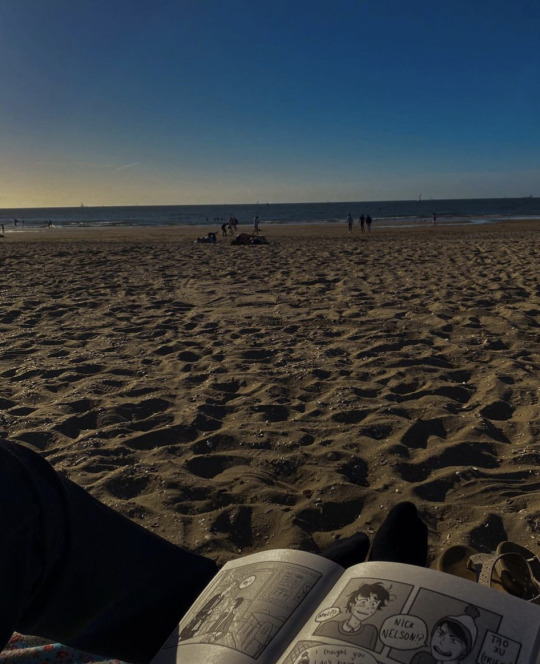
2021-2022 highlights , including one year anniversary trip to Maastricht with my partner, a date at a berry picking farm , and reading heartstopper on the beach
#howdyrevchaos#original post#netherlands#maastricht#den haag#scheveningen#framblij#holland#aesthetic#study abroad
4 notes
·
View notes
Text

Endowed with a martial temperament, Catherine Meurdrac de la Guette (1613–c.1681) showed her courage by defending her holdings during troubled times. Her Memoirs offer a unique testimony to the life and responsibilities of a strong-willed woman.
The education of a lady
Catherine was born in 1613 in Mandres to Vincent Meurdrac and Elizabeth Dovet, members of the local nobility. She had an older sister, Marie, who would later write a chemistry treatise for women. From an early age, Catherine’s mother involved her in the management of the household. Catherine remembered her fondly and always found in her a supportive presence.
At age 12, she was sent to Paris to live with her maternal uncle and receive the education of a proper lady of the capital. Once her education was complete, Catherine returned to her family. She then asked her father for permission to study with a master-at-arms, which he granted.
Catherine became skilled with a sword, training against her cousins, and adept in the use of firearms. She was also an accomplished horsewoman. Witty and assertive, she had a strong martial temperament and considered herself ill-suited to traditionally feminine pursuits.
As she recalled: "I have always been of a temper more given to war than tranquil endeavors. My liking is only for the beat of drums and the fanfare of trumpets”.
Secret marriage
In 1635, Catherine met an officer, Jean Marius de la Guette. The pair fell in love, but her father opposed the match. With the help of her mother, they married in secret, and Catherine went to live with her husband. Her father was furious when he learned the news, but eventually reconciled with his daughter.
Catherine and her husband were close—they hunted and rode together. But war loomed on the horizon.
A lady in charge
Catherine’s life was marked by conflict, first during the Thirty Years’ War (1618–1648), then during the Fronde (1648–1653), a revolt by parts of the nobility against the royal house.
With her husband frequently away in battle, Catherine defended their estates with poise and energy. Loyal to the king, she faced down looting and marauding soldiers—whether Frondeurs or royalists.
She rode out with a small guard to maintain order and earned widespread respect, with some comparing her to the warrior Madame de Saint-Baslemont. On one occasion, she confronted a group of soldiers who were stealing her grain. When they saw her arrive, armed and resolute, they swore they would only pillage neighboring lands. She also sheltered girls and women on her estates to protect them from rape.
In 1653, Catherine travelled to Bordeaux dressed in male attire and accompanied by a small escort, to negotiate with rebel princes on behalf of Queen Mother Anne of Austria. To do so, she had to cross enemy lines twice.
A mother’s grief
Catherine’s husband died in 1655, a loss that greatly affected her. In 1672, she followed her two sons to Holland, where they had gone to fight for the United Provinces. Her eldest son died in 1676 at the siege of Maastricht.
Catherine’s Memoirs end with the terrible grief she experienced on learning of his death. It was after this event that she decided to write the story of her life. Her memoirs were published in Holland. She likely died there in 1681.
Catherine’s Memoirs
Aside from her martial deeds, Catherine is remembered for her Memoirs, in which she recounts her life from childhood to the death of her son. She begins by noting that many men had the chance to tell their stories—and that she would be one of the few women to tell hers.
Though later forgotten, her Memoirs were rediscovered, prompting some doubts about their authenticity. Was Madame de la Guette a real person? Careful verification confirmed not only her existence, but also the truth of the events she described. Catherine’s story thus stands as a unique and precious historical testimony.
In 1841, a novelist invented an ending for her, imagining her dying in a duel against three men. This, however, is pure fiction.
If you enjoy this blog, consider supporting me on Ko-fi!
Further reading:
De Musset Paul, Madame de la Guette
Freudmann Felix Raymond, The Memoirs of Madame de la Guette : a Study
Lalaguë-Guilhemsans Marie-Thérèse, “La Guette, Madame De”, in: Higham Robin, Pennington Reina (eds.), Amazons to fighter pilots, biographical dictionary of military women, vol.1
Meurdrac de la Guette Catherine, Mémoires de Madame de la Guette
#catherine meurdrac#madame de la guette#history#women in history#historyedit#france#french history#17th century#female authors#women warriors#warrior women#herstory
64 notes
·
View notes
Text

At 93, he’s as fit as a 40-year-old. His body offers lessons on aging.
The human body maintains the ability to adapt to exercise at any age, showing that it’s never too late to start a fitness program
By Gretchen Reynolds
For lessons on how to age well, we could do worse than turn to Richard Morgan.
At 93, the Irishman is a four-time world champion in indoor rowing, with the aerobic engine of a healthy 30- or 40-year-old and the body-fat percentage of a whippet. He’s also the subject of a new case study, published last month in the Journal of Applied Physiology, that looked at his training, diet and physiology.
Live well every day with tips and guidance on food, fitness and mental health, delivered to your inbox every Thursday.
Its results suggest that, in many ways, he’s an exemplar of fit, healthy aging — a nonagenarian with the heart, muscles and lungs of someone less than half his age. But in other ways, he’s ordinary: a onetime baker and battery maker with creaky knees who didn’t take up regular exercise until he was in his 70s and who still trains mostly in his backyard shed.
Even though his fitness routine began later in life, he has now rowed the equivalent of almost 10 times around the globe and has won four world championships. So what, the researchers wondered, did his late-life exercise do for his aging body?
Lessons on aging from active older people
“We need to look at very active older people if we want to understand aging,” said Bas Van Hooren, a doctoral researcher at Maastricht University in the Netherlands and one of the study’s authors.
Many questions remain unanswered about the biology of aging, and whether the physical slowing and declines in muscle mass that typically occur as we grow older are normal and inevitable or perhaps due, at least in part, to a lack of exercise.
Start the year fresh
If some people stay strong and fit deep into their golden years, the implication is that many of the rest of us might be able to as well, he said.
Helpfully, his colleague Lorcan Daly, an assistant lecturer in exercise science at the Technological University of the Shannon in Ireland, was quite familiar with an example of successful aging. His grandfather is Morgan, the 2022 indoor-rowing world champion in the lightweight, 90-to-94 age group.
What made Morgan especially interesting to the researchers was that he hadn’t begun sports or exercise training until he was 73. Retired and somewhat at loose ends then, he’d attended a rowing practice with one of his other grandsons, a competitive collegiate rower. The coach invited him to use one of the machines.
“He never looked back,” Daly said.
Highest heart rate on record
They invited Morgan, who was 92 at the time, to the physiology lab at the University of Limerick in Ireland to learn more, measuring his height, weight and body composition and gathering details about his diet. They also checked his metabolism and heart and lung function.
They then asked him to get on a rowing machine and race a simulated 2,000-meter time trial while they monitored his heart, lungs and muscles.
“It was one of the most inspiring days I’ve ever spent in the lab,” said Philip Jakeman, a professor of healthy aging, physical performance and nutrition at the University of Limerick and the study’s senior author.
Morgan proved to be a nonagenarian powerhouse, his sinewy 165 pounds composed of about 80 percent muscle and barely 15 percent fat, a body composition that would be considered healthy for a man decades younger.
During the time trial, his heart rate peaked at 153 beats per minute, well above the expected maximum heart rate for his age and among the highest peaks ever recorded for someone in their 90s, the researchers believe, signaling a very strong heart.
His heart rate also headed toward this peak very quickly, meaning his heart was able to rapidly supply his working muscles with oxygen and fuel. These “oxygen uptake kinetics,” a key indicator of cardiovascular health, proved comparable to those of a typical, healthy 30- or 40-year-old, Daly said.
Exercising 40 minutes a day
Perhaps most impressive, he developed this fitness with a simple, relatively abbreviated exercise routine, the researchers noted.
Consistency: Every week, he rows about 30 kilometers (about 18.5 miles), averaging around 40 minutes a day.
A mix of easy, moderate and intense training: About 70 percent of these workouts are easy, with Morgan hardly laboring. Another 20 percent are at a difficult but tolerable pace, and the final 10 at an all-out, barely sustainable intensity.
Weight training: Two or three times a week, he also weight-trains, using adjustable dumbbells to complete about three sets of lunges and curls, repeating each move until his muscles are too tired to continue.
A high-protein diet: He eats plenty of protein, his daily consumption regularly exceeding the usual dietary recommendation of about 60 grams of protein for someone of his weight.
How exercise changes how we age
“This is an interesting case study that sheds light on our understanding of exercise adaptation across the life span,” said Scott Trappe, director of the Human Performance Laboratory at Ball State University in Indiana. He has studied many older athletes but was not involved in the new study.
“We are still learning about starting a late-life exercise program,” he added, “but the evidence is pretty clear that the human body maintains the ability to adapt to exercise at any age.”
In fact, Morgan’s fitness and physical power at 93 suggest that “we don’t have to lose” large amounts of muscle and aerobic capacity as we grow older, Jakeman said. Exercise could help us build and maintain a strong, capable body, whatever our age, he said.
Of course, Morgan probably had some genetic advantages, the scientists point out. Rowing prowess seems to run in the family.
And his race performances in recent years have been slower than they were 15, 10 or even five years ago. Exercise won’t erase the effects of aging. But it may slow our bodies’ losses, Morgan’s example seems to tell us. It may flatten the decline.
It also offers other, less-corporeal rewards. “There is a certain pleasure in achieving a world championship,” Morgan told me through his grandson, with almost comic self-effacement.
“I started from nowhere,” he said, “and I suddenly realized there was a lot of pleasure in doing this.”
15 notes
·
View notes
Text

I am Kaat van der Leeuw.
I am currently in my fourth year at the Willem de Kooning Academy, where I am pursuing a degree in Spatial Design. And I am doing a Minor at Bouwkunde. Before joining Willem de Kooning, I spent 2.5 years studying in Maastricht, focusing on architecture and interior design at the art academy.
As a designer, my focus lies in understanding the human experience within a space and how it can be influenced. Additionally, my work revolves around evoking emotions and creating spaces that offer meaningful experiences.
2 notes
·
View notes
Text
Deliberate.
I’ll rewrite this later, more warmly. For now, if it helps, read it in the voice of your favourite TV Spock. (Obviously that’s Ethan Peck, right?)
Thanks to genetics¹, I lack what I call instinctive empathy. I don't involuntarily yawn when others yawn, or reflexively cross my legs to match the way people nearby cross theirs, or find myself snap-reacting to a subtle facial cue.
What’s cool about that, is that in order to avoid the deep social/career costs of being “that guy with the personality of a bar code reader” I learned how to develop deliberate empathy. Conscious competence to compensate for unconscious incompetence.
Deliberate empathy means a lot of daily synthesis, emulation, and trial-and-error. Like a meat version of machine learning. And it’s probably more common than we’d guess (you may be doing it, without knowing you are, which is also normal; blending in is an ancient, proven survival tactic).
Think of it like that hamburger they’re growing in Petri dishes at Maastricht University. Or like Siri and Alexa will be, one day. They’re only “fake” insofar as they���re brought about by different means than we’re told they’re supposed to. Deliberate empathy isn’t fake, it’s just brought about differently.
In some ways, I think the lack of instinctive empathy is advantageous. I sometimes think that people born naturally inclined to empathy probably take it for granted, but don’t always notice life’s baggage slowly calcifying that natural gift. Meanwhile, people who've learned (usually painfully) that they’re naturally awful at something as socially pass/fail as “relating” are going to constantly put effort into it, because they know what's at stake.
I’ve sometimes wondered whether there’s any connection between my lacking instinctive empathy, and my being aromantic. I honestly don’t know. I’ve been too busy meeting the aroace (and wider aspec) community, and just getting used to being quasi-out, this year, to really dig into it. Has anyone here seen (or even been involved with) any serious scientific study into that kind of thing? I don’t think one causes the other, but I wouldn’t be surprised if they share some kind of common building blocks.
¹ I have genotype A/A on marker rs53576 in gene OXTR (position 8804371), and genotype G/G on marker rs1042778 in gene OXTR (position 8794545). OXTR as in “oxytocin receptor”. In fairly large studies those two genotypes correlated with what gets super-simplified as “no empathy” and “callous-unemotional” ².
² People like me have plenty of feelings. We just don’t regularly share them, because it’s hard to read others’ reactions to what we’re sharing. Funny dumb trivia: When I’m sharing something I feel deeply passionate about, or something very personal, I get so worked up worrying about whether I’ve shared that thought/info too soon, or too bluntly, that my jaw will start to chatter like I have hypothermia or something.

[Image description: an image grid showing a tin lunchbox I converted into a Bluetooth speaker, to symbolize how people like me seem tinny and robotic, but we've done lots of work to have rich inner lives and be as sociable as we can.]
16 notes
·
View notes
Text
Some brief observations on railroad operations, not really with a point, just musing. So a couple of weeks ago I arrived in Aachen central station, as I often do, from Cologne, on the RE9 train service. This was delayed by about ten minutes, which is actually below average for trains from Cologne to Aachen in the evening, and while we all wish it didn’t happen, it’s not that big a deal.
As the train pulled into the station, another train was on the track on the other side of the platform, the RB33 to Duisburg, about to depart shortly. This is a very useful cross-platform transfer for anyone who wants to go north from here, so yay!
Except on this evening, someone had decided that the RB33 train set that had run into Aachen station needed to be pulled out of service, and replaced by another one. I don’t know why so I’m going to assume it was for valid reasons. This operation was actually well prepared: The replacement train was pulling in basically at the same time as my RE9. Since the track was blocked by the old train, it had to pull in to a different platform, though, but there was one free so that wasn’t a problem.
However, finding out about this was quite a bit of a challenge. The old train’s destination signs and internal displays happily announced it was going to Duisburg as intended, until eventually train staff chased everyone out and turned out the lights, some ten minutes after the train was due to depart.
The automatic announcements on the platform completely neglected to mention this. According to them, the RB33 to Duisburg was still on the same track as before. The big display signs, on the other hand, knew what was up, and showed it correctly („Train from Duisburg, do not enter, train to Duisburg from platform 6“). They did so until the scheduled departure time of the train, which came and went with nothing much happening. After that, they showed information for the next train, the RE18 to Maastricht.
That led to a situation where the old train was sitting there, announcing it was heading to Duisburg, while the train displays and automatic announcements said there was a train right here heading to Maastricht. If you’re a very dedicated reader of this blog then you know of course that the train to Maastricht is blue and white, not red, but you can hardly fault people for being confused, and in fact they were.
In the end, the crucial information („don’t take this train to Duisburg, take the one on the other track“) was relayed by train staff from the stricken train, who just made an effort to tell everyone on the platform personally in passing. That was honestly great of them, kudos for that! But it’s not their job, and it doesn’t scale well. I’m sure there are people who didn’t get reached by that.
In the end, the old Duisburg train departed towards the depot, lights out and presumably empty; the new Duisburg train left as well, and the one to Maastricht too, both delayed by between ten and twenty minutes. People on the Maastricht train who wanted to go anywhere else in the Netherlands almost certainly missed the very tight connection window at Heerlen, but the connecting train runs every thirty minutes so it probably didn’t throw off their evening too much. I don’t know whether anybody got left at Aachen who wanted to be on the Duisburg train.
For me, this is just an interesting case study in how the German rail network keeps missing operational excellence. Nothing about this situation, neither it existing at all nor the delays nor the bad information, is at all surprising if you have some experience with the system. Stuff like that just happens, and the overall system is terrible at dealing with it. Most regional trains spend a long time just parked in Aachen, but clearly that isn’t long enough to properly handle this ultimately rather straightforward thing.
It doesn’t help that we have a lot of different systems in play here. The train is run by DB Regio NRW, and it was probably their operations department that decided on the swap, and failed to ensure the train’s signage reflected it. DB Netz runs the tracks and created the schedules, both original and on-the-fly replacements, and directed each train where it needed to go, so they were probably in the loop fairly early on.
Then there is also DB Station & Service, bizarrely a different company that handles everything about stations that isn’t tracks, who are responsible for the announcements and displays on the platform, using the information provided to them by DB Regio NRW - not DB Netz, even though they have the best idea what’s actually running since they turn the signals green for it.
The Maastricht train is not DB Regio NRW, but Arriva Netherlands, which is part of the DB group of companies, but held a bit of an arms length and with their own dutch-speaking operations department headquartered in the Netherlands.
Finally, since train operating companies are responsible for generating information for the display signs, but DB Station & Service is responsible for displaying it at stations (and DB Fernverkehr on the popular DB Navigator app; most other apps also get their information from the same DB data source), there have been many instances where information was not transmitted properly. The state of North-Rhine Westphalia has taken on more responsibilities in collecting and sharing real-time data here, and now publishes that via its zuginfo.nrw central platform. My understanding is that this is supposed to send the information to DB Station & Service, but I wasn’t able to find any actual source for that, so it may be wrong.
But all that didn’t work, partly because the train destination displays weren’t updated, partly because the automatic announcements didn’t deem it important, and partly because the displays were not aware that the old train was still right there on the track (and the one after it delayed) even when it should have already been in the depot.
In the grand total of things this is a nothing-burger. I’ve seen worse even on that very same day (why were all these angry people trying to get into the Eurocity to Hamburg? Can’t have been a good reason). But it’s fascinating how such small things fail, and what that says for the overall resilience of the system. Is it any wonder that most German trains I’ve been on this year have been delayed in some form or another?
We need to fix a lot of things on this country’s rail system, including a lot of aging infrastructure that needs to be replaced and, in a true catch-22, too many construction sites on the rails, as well as issues like staff shortages, deferred modernisation and so on. But the fact that we can still not get this right almost twenty years after the modern DB was founded speaks volumes about flaws in the fundamental structure. I’m not saying an integrated system is the only way to go, but clearly the current level of integration and cooperation isn’t good enough. This isn’t a new revelation (that’s why zuginfo.nrw was created after all), but it’s still important to note it.
4 notes
·
View notes
Text
Research: Māori and AI, Robot marriage
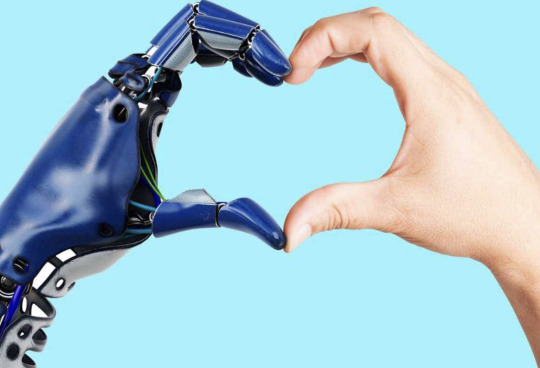
30 March 2024
Did some robot research in the weekend. Found an interesting article discussing how some Māori are critical of AI generated imagery as soulless. "AI has no mauri, no wairua. It creates nothing on its own".
"As opinions clash on the role of AI in te ao Māori, some adamantly believe it has "no place in te ao Māori", while others see its potential in language revitalisation and innovative progress for te iwi Māori. The clash sets the stage for an ongoing, unavoidable intersection of technology and tradition." "
"Moreover, the concern extends to the use of AI in language translation. It's not just about the words; it's about the deeper understanding embedded in the process of learning te reo Māori. Questions arise: "Who did you learn from? Where did you learn? What deeper understanding exists?" AI offers a shortcut to understanding the language without the personal investment and cultural context, ultimately resulting in a loss of mauri and wairua (essence, vitality, spiritual essence).
"A follower shares, "The context of learning is so important, too. Because you're not just learning a language. You're learning its history, the cultural context and how all the parts of te ao Māori are interconnected."
A second article about marriage with robots had an interesting counterpoint to Māori opinion that AI and (by extension) Robots lack mauri. It references Japanese faith which holds that every object has a soul, including robots.
"In addition, Japanese religious beliefs allow robots to have a soul. Shintoism holds that every object has a soul, so robots must have one as well. It makes the theme of love between humans and robots more acceptable in this culture than in other civilizations."
"In Asian countries, especially Japan and South Korea, the perception of robots as intimate partners is already quite positive. Anime series in both countries often show love or sex between robots and humans."
On robot marriage:
"Dr. David Levy is convinced that people may prefer robots as partners within a few decades. Many will begin to live with them, enter into intimate relationships, and marry a soulless machine. Moreover, researchers from Maastricht University believe that by 2050 the government will legalize marriages with robots."
"The idea of romantic relationships between humans by artificial creations is as old as the world. In Greece, there is a myth from ancient times about Pygmalion, who fell in love with an ivory statue, which Venus then gave life. Forty years ago, scientists also noticed that students were genuinely interested in the computer program ELIZA, designed to ask questions and act as a therapist. Confirmed studies confirm that in the future, robots will become so similar to humans that people will start to make love to them, have sex with them, and even marry them."
"The main advantage of human-robot marriage is that it can make people who cannot get married any other way happy. It applies to those who have difficulty in relationships because of their extreme shyness, who have any psychological problems, or who are unattractive or have an unpleasant character."
Another article discusses how latest research suggests women are more likely to look for friendships with robots, whereas men are more likely to seek robots as sexual partners.
"On the other side of the spectrum, the study introduces the concept of Robofriendship. This is a platonic connection with robots, primarily observed among women.
Unlike robosexuality, robofriendship revolves around forming meaningful emotional bonds and companionship with robots. These women find a safe space with humanoids and often form a deep connection with them.
These women are often particularly those with lower levels of social dominance orientation and hostile sexism. So, they exhibit a greater inclination towards fostering friendships with robots. Notions of social equity and reciprocity draw them."
The last article I found discusses what's meant by a humanoid robot. In essence, they have the ability to perform humanlike tasks and have a humanlike form.
"Robots made their stage debut the day after New Year’s 1921. ... "Karel Čapek’s play, R.U.R (Rossumovi Univerzální Roboti), was a hit. It was translated into dozens of languages and played across Europe and North America. The work’s lasting legacy, however, was its introduction of the word “robot.”"
"For many, the humanoid form is still the platonic robot ideal — it’s just that the state of technology hasn’t caught up to that vision."
"Another element I tend to consider is the degree to which the humanlike form is used to perform humanlike tasks. This element isn’t absolutely necessary, but it’s an important part of the spirit of humanoid robots. After all, proponents of the form factor will quickly point out the fact that we’ve built our worlds around humans, so it makes sense to build humanlike robots to work in that world."
2 notes
·
View notes
Text

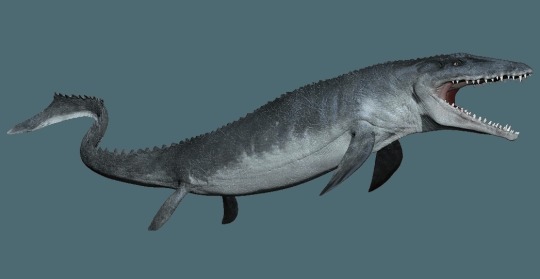
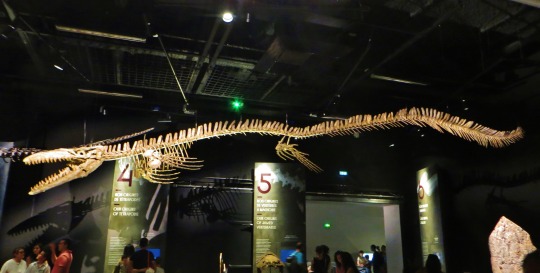
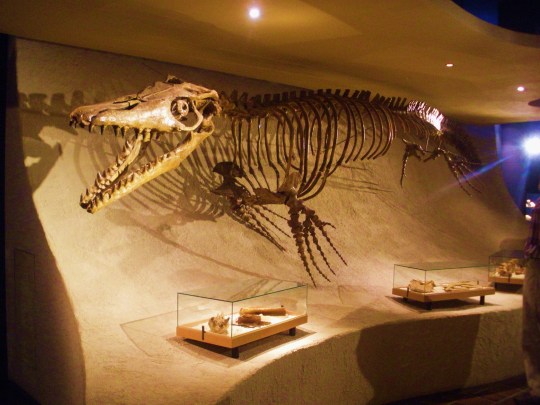
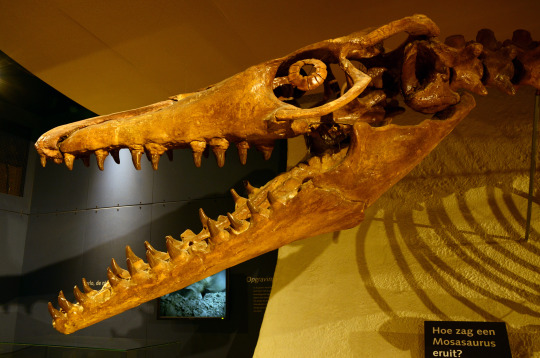
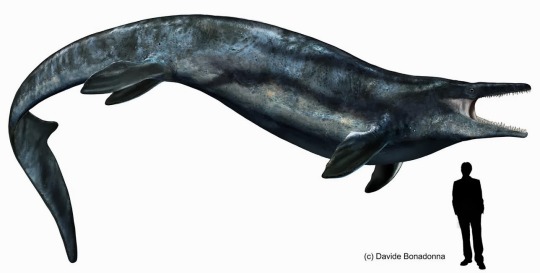

Mosasaurus
(temporal range: 82.7-66.0 mio. years ago)
[text from the Wikipedia article, see also link above]
Mosasaurus (/ˌmoʊzəˈsɔːrəs/; "lizard of the Meuse River") is the type genus (defining example) of the mosasaurs, an extinct group of aquatic squamate reptiles. It lived from about 82 to 66 million years ago during the Campanian and Maastrichtian stages of the Late Cretaceous. The genus was one of the first Mesozoic marine reptiles known to science—the first fossils of Mosasaurus were found as skulls in a chalk quarry near the Dutch city of Maastricht in the late 18th century, and were initially thought to be the bones of crocodiles or whales. One skull discovered around 1780, which was seized by France during the French Revolutionary Wars for its scientific value, was famously nicknamed the "great animal of Maastricht". In 1808, naturalist Georges Cuvier concluded that it belonged to a giant marine lizard with similarities to monitor lizards but otherwise unlike any known living animal. This concept was revolutionary at the time and helped support the then-developing ideas of extinction. Cuvier did not designate a scientific name for the new animal, and this was done by William Daniel Conybeare in 1822 when he named it Mosasaurus in reference to its origin in fossil deposits near the Meuse River. The exact affinities of Mosasaurus as a squamate remain controversial, and scientists continue to debate whether its closest living relatives are monitor lizards or snakes.
Traditional interpretations have estimated the maximum length of the largest species, M. hoffmannii, to be up to 17.1 meters (56 ft), making it one of the largest mosasaurs, although some scientists consider this an overestimation with recent estimates suggesting a length closer to 13 meters (43 ft). The skull of Mosasaurus was equipped with robust jaws capable of swinging back and forth and strong muscles capable of powerful bites using dozens of large teeth adapted for cutting prey. Its four limbs were shaped into robust paddles to steer the animal underwater. Its tail was long and ended in a downward bend and a paddle-like fluke. Mosasaurus was a predator possessing excellent vision to compensate for its poor sense of smell, and a high metabolic rate suggesting it was endothermic ("warm-blooded"), an adaptation in squamates only found in mosasaurs. There is considerable morphological variability across the currently-recognized species in Mosasaurus—from the robustly-built M. hoffmannii to the slender and serpentine M. lemonnieri—but an unclear diagnosis (description of distinguishing features) of the type species M. hoffmannii led to a historically problematic classification. As a result, more than fifty different species have been attributed to the genus in the past. A redescription of the type specimen in 2017 helped resolve the taxonomy issue and confirmed at least five species to be within the genus. Another five species still nominally classified within Mosasaurus are planned to be reassessed in a future study.
Fossil evidence suggests Mosasaurus inhabited much of the Atlantic Ocean and the seaways adjacent to it. Mosasaurus fossils have been found in places as diverse as North and South America, Europe, Africa, Western Asia, and Antarctica. This distribution encompassed a wide range of oceanic climates including tropical, subtropical, temperate, and subpolar climates. Mosasaurus was a common large predator in these oceans and was positioned at the top of the food chain. Paleontologists believe its diet would have included virtually any animal; it likely preyed on bony fish, sharks, cephalopods, birds, and other marine reptiles including sea turtles and other mosasaurs. It likely preferred to hunt in open water near the surface. From an ecological standpoint, Mosasaurus probably had a profound impact on the structuring of marine ecosystems; its arrival in some locations such as the Western Interior Seaway in North America coincides with a complete turnover of faunal assemblages and diversity. Mosasaurus faced competition with other large predatory mosasaurs such as Prognathodon and Tylosaurus—which were known to feed on similar prey—though they were able to coexist in the same ecosystems through niche partitioning. There were still conflicts among them, as an instance of Tylosaurus attacking a Mosasaurus has been documented. Several fossils document deliberate attacks on Mosasaurus individuals by members of the same species. In fighting likely took place in the form of snout grappling, similarly seen in modern crocodiles today.
6 notes
·
View notes
Text
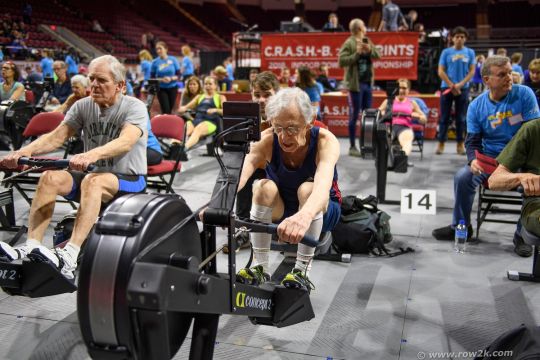
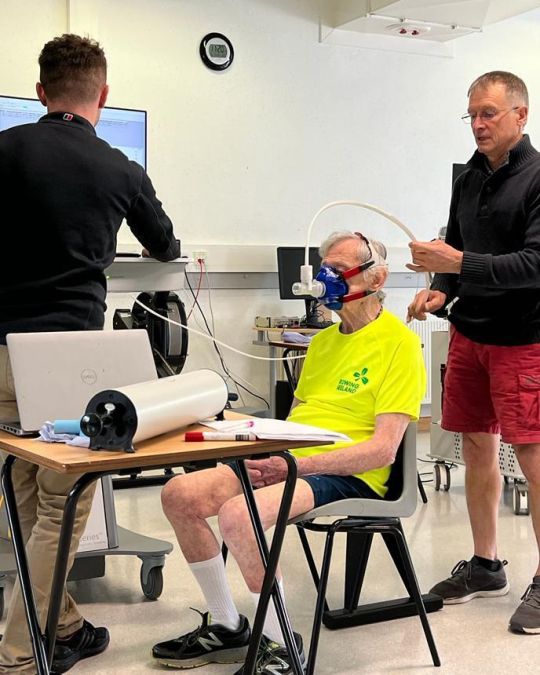

"The body fat of a Whippet?" At age 93?
(Washington Post) At 93, he’s as fit as a 40-year-old. His body offers lessons on aging. | The human body maintains the ability to adapt to exercise at any age, showing that it’s never too late to start a fitness program
by Gretchen Reynolds
PHOTO: Richard Morgan competes in an indoor rowing competition in 2018. (Row2k.com)
For lessons on how to age well, we could do worse than turn to Richard Morgan.
At 93, the Irishman is a four-time world champion in indoor rowing, with the aerobic engine of a healthy 30- or 40-year-old and the body-fat percentage of a whippet. He’s also the subject of a new case study, published last month in the Journal of Applied Physiology, that looked at his training, diet and physiology.
Its results suggest that, in many ways, he’s an exemplar of fit, healthy aging — a nonagenarian with the heart, muscles and lungs of someone less than half his age. But in other ways, he’s ordinary: a onetime baker and battery maker with creaky knees who didn’t take up regular exercise until he was in his 70s and who still trains mostly in his backyard shed.
Even though his fitness routine began later in life, he has now rowed the equivalent of almost 10 times around the globe and has won four world championships. So what, the researchers wondered, did his late-life exercise do for his aging body?
“We need to look at very active older people if we want to understand aging,” said Bas Van Hooren, a doctoral researcher at Maastricht University in the Netherlands and one of the study’s authors.
Many questions remain unanswered about the biology of aging, and whether the physical slowing and declines in muscle mass that typically occur as we grow older are normal and inevitable or perhaps due, at least in part, to a lack of exercise.
If some people stay strong and fit deep into their golden years, the implication is that many of the rest of us might be able to as well, he said.
Helpfully, his colleague Lorcan Daly, an assistant lecturer in exercise science at the Technological University of the Shannon in Ireland, was quite familiar with an example of successful aging. His grandfather is Morgan, the 2022 indoor-rowing world champion in the lightweight, 90-to-94 age group.
What made Morgan especially interesting to the researchers was that he hadn’t begun sports or exercise training until he was 73. Retired and somewhat at loose ends then, he’d attended a rowing practice with one of his other grandsons, a competitive collegiate rower. The coach invited him to use one of the machines.
“He never looked back,” Daly said.
Morgan joined researchers at the physiology lab at the University of Limerick in Ireland. (Lorcan Daly) Highest heart rate on record
They invited Morgan, who was 92 at the time, to the physiology lab at the University of Limerick in Ireland to learn more, measuring his height, weight and body composition and gathering details about his diet. They also checked his metabolism and heart and lung function.
They then asked him to get on a rowing machine and race a simulated 2,000-meter time trial while they monitored his heart, lungs and muscles.
“It was one of the most inspiring days I’ve ever spent in the lab,” said Philip Jakeman, a professor of healthy aging, physical performance and nutrition at the University of Limerick and the study’s senior author.
Morgan proved to be a nonagenarian powerhouse, his sinewy 165 pounds composed of about 80 percent muscle and barely 15 percent fat, a body composition that would be considered healthy for a man decades younger.
During the time trial, his heart rate peaked at 153 beats per minute, well above the expected maximum heart rate for his age and among the highest peaks ever recorded for someone in their 90s, the researchers believe, signaling a very strong heart.
His heart rate also headed toward this peak very quickly, meaning his heart was able to rapidly supply his working muscles with oxygen and fuel. These “oxygen uptake kinetics,” a key indicator of cardiovascular health, proved comparable to those of a typical, healthy 30- or 40-year-old, Daly said.
Exercising 40 minutes a day Perhaps most impressive, he developed this fitness with a simple, relatively abbreviated exercise routine, the researchers noted.
Consistency: Every week, he rows about 30 kilometers (about 18.5 miles), averaging around 40 minutes a day. A mix of easy, moderate and intense training: About 70 percent of these workouts are easy, with Morgan hardly laboring. Another 20 percent are at a difficult but tolerable pace, and the final 10 at an all-out, barely sustainable intensity. Weight training: Two or three times a week, he also weight-trains, using adjustable dumbbells to complete about three sets of lunges and curls, repeating each move until his muscles are too tired to continue. A high-protein diet: He eats plenty of protein, his daily consumption regularly exceeding the usual dietary recommendation of about 60 grams of protein for someone of his weight.
PHOTO: Richard Morgan with his wife, Rita. (Family photo)
How exercise changes how we age
“This is an interesting case study that sheds light on our understanding of exercise adaptation across the life span,” said Scott Trappe, director of the Human Performance Laboratory at Ball State University in Indiana. He has studied many older athletes but was not involved in the new study.
“We are still learning about starting a late-life exercise program,” he added, “but the evidence is pretty clear that the human body maintains the ability to adapt to exercise at any age.”
In fact, Morgan’s fitness and physical power at 93 suggest that “we don’t have to lose” large amounts of muscle and aerobic capacity as we grow older, Jakeman said. Exercise could help us build and maintain a strong, capable body, whatever our age, he said.
Of course, Morgan probably had some genetic advantages, the scientists point out. Rowing prowess seems to run in the family.
And his race performances in recent years have been slower than they were 15, 10 or even five years ago. Exercise won’t erase the effects of aging. But it may slow our bodies’ losses, Morgan’s example seems to tell us. It may flatten the decline.
It also offers other, less-corporeal rewards. “There is a certain pleasure in achieving a world championship,” Morgan told me through his grandson, with almost comic self-effacement.
“I started from nowhere,” he said, “and I suddenly realized there was a lot of pleasure in doing this.”
Do you have a fitness question? Email [email protected] and we may answer your question in a future column.
#refrigeratormagnet
2 notes
·
View notes
Text
TIMELINE HELSINKI
1905 - first Russian revolution, Freud's theory of sexuality, Potemkin incident
1912 - Stanislawski's acting method is created.
1914- assassination of Archduke Franz Ferdinand of Austria, beginning of World War I.
1915- Franz Kafka, The Metamorphosis
1916- Zurich, Cabaret Voltaire
1917 - Bolshevik Revolution
1918 - Assassination of the Tsar and the Romanov family
1922 - March on Rome and coming to power of Mussolini
1929 - Mayakovsky's bug. Prisypkin is frozen as a result of a fire during his wedding.
1930 - Mayakovsky's suicide.
1931- Second Spanish Republic
1932-33- Great famine in Ukraine, Holodomor (famine). Between 3 and 5 million people died.
1933- Hitler comes to power in Germany.
1936- Spanish Civil War. Murder of García Lorca.
1938 - Kristallnacht (Night of Broken Glass). First awareness of climate change: Guy Callendar connected carbon dioxide increases in Earth's atmosphere to global warming.
1939 - Invasion of Poland and beginning of World War II.
1940 - Torutra and execution of Vsevolod Meyerhold.
1945 - The US drops two nuclear bombs on Hiroshima and Nagasaki in Japan.
1947 - For the first time, insects are launched into space: In 1947, the United States sends fruit flies (Drosophila melanogaster) into space aboard a V2 rocket. They were the first animals in space and were part of a series of experiments to study the effects of cosmic rays on living organisms.
1947 - beginning of the Cold War (Mar 12, 1947 – Dec 25, 1991) tensions between United States and Soviet Union, that fed into the Vietnam War and the Korean War.
1948 - Nakba, and creation of the state of Israel.
1950 - Invention of Artificial Intelligence
1952 - 6 February, Queen Elizabeth is crowned, she will be queen until her death in 1922, being the longest reigning monarch ever.
1955 - First documenta in Kassel.
1955 - First Israeli raid on Gaza.
1959 - First color TV broadcast
1960 - The contraceptive pill for women is marketed. The Beatles forms as a band in Liverpool.
1961 - First man launched into space: Yuri Gagarin
1964 - US Congress passesThe Civil Rights Act of 1964 prohibiting discrimination based on race, color, religion, sex, or national origin
1966 - Earth is photographed from space
1968 - Tlatelolco Tragedy, May 68 in France. Murder of Martin Luther King
1969 - Riots at the Stone Wall, marking the beginning of gay rights struggle
1971 - Commercialization of the first Intel 4004 microchip. Abandonment of the gold standard by Richard Nixon.
1972 - Since 1972, no more humans have travelled beyond low Earth orbit, since the Apollo 17 lunar mission in December 1972.
1973 - Coup in Chile, death of Salvador Allende. Yom Kippur War - The Yom Kippur War, also known as the Ramadan War, the October War, the 1973 Arab–Israeli War, or the Fourth Arab–Israeli War, was an armed conflict fought from 6 to 25 October 1973, between Israel and a coalition of Arab states led by Egypt and Syria.
1975 - Thrilla in Manilla, Muhammad Ali faces Joe Frazier.
1978 - The Russian-Afghan war begins. It will end in 1992.
1979 - Prisypkin wakes up. The Clockwise Experiment: This concept was first developed and tested in 1979 in Ellen Langer's "counterclockwise" study, which examined the psychological effects of turning back the clock on the physiological state of an older adult. The research question was, "If we set the mind back twenty years, will the body reflect this change?"
1980 - Vigdís Finnbogadóttir is elected president of Iceland becoming the first female president.
1981- AIDS crisis.
1983 - January first, Internet was invented
1989- Fall of the Berlin Wall. Tiananmen Square, protests and massacre. Francis Fukuyama publishes "The End of History". Creation of the World Wide Web.
1990 - Nelson Mandela is released from prison.
1991 - Invention of the world wide web (Tim Berners-Lee integrated hypertext software with the Internet)
1992 - Maastricht Treaty
1993 - April 30, The World Wide Web became available to the broader public
1996 - Death of Tupac Shakur
1997 - Death of Princess Diana of Wales. Launching of SixDegrees, considered the first social media. Asian Financial Crisis begins in Thailand and spreads quickly to the rest of East and Southeast Asia. The United Nations adopts the Kyoto protocol, and this is considered the climax of Green Capitalism or EcoCapitalism, an approach to managing the relationships between economic activities and the environment that presumes a large degree of compatibility between capitalism and current efforts to reduce human impacts on the non-human world. Harry Potter and The Philosopher's Stone is published.
1999 - Putin comes to power in Russia.
2000 - Y2K. Y2K was a computer glitch, or bug, that may have caused problems when dealing with dates after December 31, 1999.
2001 - 9/11, Terrorist attack, two planes crash against the Twin Towers in NY, which collapse. Beginning of the "US war on terror".
2003- Beyoncé releases "Dangerously in Love". Beyoncé is 21 and already dating Jay Z.
2007 - #metoo
2008 - War in Georgia. Bankrupcy of Lehman Brothers, climax of the subprime mortgage crisis
2009 - Ru Paul's drag race. Michael Jackson dies.
2011 - Arab Spring. Occupy movement. 11M. Beginning of the Civil Syrian War.
2014 - Russia invades Donbas and annexes Crimea. Beginning of the Russian-Ukranian War.
2016 - Murder of eco-activist Berta Cáceres.
2017 - Hollywood's #metoo
2018 - First Fridays for Climate Greta Thumberg strikes.
2020 - COVID. Murder of George Floyd. BREXIT, or withdrawal of the United Kingdom from the European Union.
2021, January 6, United States Capitol attack
2022 - Rihanna's son is born. Russia invades Ukraine and war begins. Decriminalization of sex work in Belgium. The first person who does not die is born. Jan Fabre is found guilty of sexual harassment. Spanish government approves trans law recognizing free gender self-determination. Russia invades Ukraine in an escalation of the Russo-Ukrainian War. On 16 September 2022, murder of Mahsa Amini and beginning of the movement Woman, Life, Freedom. Woman, Life, Freedom, is a popular Kurdish slogan used in both the Kurdish independence and democratic confederalist movements. The slogan became a rallying cry during the protests which occurred in Iran as a response to the death of Mahsa Amini.
2023 - Following an incursion of Hamas into Israel, Israel launches Gaza Genocide and escalates ethnic cleansing in Palestine.
NOW
2030 - The increase in global temperature is irreversible.
2031 - Third Spanish Republic
2032 - There is one person alive left on facebook
2039- Crypto Crash
2050 - Ecological Collapse
Somewhere soon:
- rising inequality
- massive emigration - climate change reffugees
- war and violence
- decentralized government - municipalism
- radical different ways of living and being together
- forced changes in consuming habits
- life without work - automatisation buses will drive themselves and cars too and planes and robots will serve domestic robots and sexual work too
- UBI
- everyone will be an artist, finally
- new pandemics
- no more consumption of meat and fish
- population will move to rural eras
- rising digital inequality
Somewhere later:
- end of the nuclear family and instead, sex with friends
- end of heteronormativity
- porn is preferred to real intercourse
- no children and gradual extinction of mankind, finally - postchildren
3,050 - Days lengthen by 1/30th of a second
10,000 - Extinction of humanity. The water level rises by 5 m in relation to the present.
2 notes
·
View notes
Text
4th September 2023
Today I finished moving into my new apartment. It took a few days, but now I think I have finally settled. A lot has happened in the months since my previous entry, almost a whole year has passed – I stopped writing because everything felt so repetitive, and constantly talking about it made me feel stuck in this murky whirlpool of cold days and aimless studying. I was drowning in myself, repeating the same words, complaining about the same problems. Endlessly.
I felt like a stick of wood stuck in the river current, an abandoned lighthouse in the storm.
Typing does not come as easy now. Documenting everything paralyzes me. Part of me feels betrayed: how dare I write about what I did today when there is no record of yesterday, of the months from February to August? I dare.
I visited a Musée Cernuschi today. It is an impressive collection of Asian art, mainly from China and Japan and Vietnam, collected by one of those nineteenth century rich French men. The sheer size of some of the sculptures stunned me. An extremely detailed bronze dragon, which was an incense burner, a winding tiger covered in some golden metal and an enormous statue of buddha got all of my attention, but the pottery was also, simply, pretty. Mundane things have a right to be pieces of art – in an ideal world a small bowl should be no less beautiful than Botticelli's Madonna della Melagrana. For this reason I have been struggling to buy things, stuff for my apartment.
It's a small room at the sixth floor of a beautiful old building, no elevator. I can see the roofs of Paris from my window. I am living in Paris now and it feels... odd. Some might say it feels like a dream, but everything feels so real, material, concrete. It's not perfect, and i know that living here will be hard, but it's better.
Moving has not gone smoothly, I had to take care of a lot of things, like signing an electricity contract and changing the washing machine and cleaning for hours, but now I'm here, on my bed, listening to music from my phone and trying not to use up all my internet data before I get WIFI installed.
–
February I got back together with my boyfriend. Everything is still so complicated, but right after I went back to Maastricht I left, without telling anyone, not even my parents, and I flew all the way to Lyon with only a few sweaters and my history of law textbook in my bag. I spent a few days with him, and everything was perfect again.
Then, during carnival we went to the mountains together. He tried to teach me how to ski, and I failed miserably, falling in the snow countless times. His parents own a little apartment, furnished with a warm wood that makes it feel smaller than it is, but never claustrophobic. He got sick and I played doctor, but it was all just an excuse for him to skip his classes and for me to stay at his place.
In March, it was his turn to come. It was a snowy month, cold, not much happened– he stayed over for a weekend. I installed a DS emulator on his laptop and we played Pokémon instead of studying, and I started doubting everything again. I always doubt everything. I still don't know if it's meticulousness or an unnerving inability to let myself have good things. We made chocolate covered strawberries, but the chocolate was not tempered and the fruit was wet.
We saw each other about once a month. My old glasses broke as I picked them up after having washed my face. The frame split without a word or a warning, and one of the lenses fell to the ground.
Once, in April, he came to Venice as I went back home for a few days during Easter. At the end of the month I went all the way to Lyon by bus and train, stopping in Lille for a few hours. Lille is a peculiar city, it feels more Belgian than French, the only way to describe it is a city proud to have been built at the border between two countries.
After my university's MUN, in May, I took the bus again to Lille, and the train again to Lyon, because M.'s university was having an end of year party. Then, we did not see each other for a long time. I got into Sorbonne. I was waitlisted at first, and I spent a few days biting my nails at the library, among all the medicine students.
I took a train to Paris in June to look for an apartment. I spend a few weeks between Venice and Rome with a Korean friend of mine. I travelled through central Italy – Assisi and Firenze and Siena – with some friends.
A lot happened. A lot. But if I started writing down everything I would not be faithful to time. It irks me to see that the most eventful moments have been centered around my relationship. I am my own person, and the passage of my time should not be dictated by kisses. Love cannot be my metronome. I am not sure if I am happy to be in a relationship: Ce. and I talked about this a few weeks ago, in Florence, and we both agreed that making decisions while in high waters is always a bad idea. She was also in high waters, with her mouth under the waves. I need to let things fall into place before I can understand my feelings fully. Perhaps writing about them will help clear out my head. Perhaps I can't just wait for things to sort them out by themselves, I need to keep unraveling this ball of yarn just to roll it back up.
Ago ergo sum. Our mandate is to create.
-c.
2 notes
·
View notes
Text

Quantum Computing Research @ UM
"Just do the calculations" is a common saying in the field of quantum computing, the development of software for quantum computers. Everything in this field is new; simply doing the math is often the best way to proceed. At Maastricht University, an interdisciplinary group of scientists works in quantum computing research, they try to do more than just the math. David Mestel and Jérémie Gobeil describe the unsolved problems in quantum computing that they are researching.
David Mestel (Department of Advanced Computing Sciences) describes the field of quantum computing as "a huge world of ignorance". David studies quantum information theory, which is a branch of science that investigates the information hidden in quantum mechanical systems such as quantum computers. He goes on to say, "In classical computing, you can incrementally improve existing algorithms, but in quantum computing, all of these algorithms need to be developed, we have only discovered a few of them. The main goal of our work is to develop new ones and improve the existing ones." Progress Physicist Jérémie Gobeil (Gravity Waves & Fundamental Physics) is studying the potential benefits of quantum computing in physics research, such as gravitational waves measured by the future Einstein Telescope. “You could apply classical computing solutions to a quantum computer, but you would gain nothing. Therefore, we need to consider other applications of quantum computers that take advantage of the unique benefits that a quantum computer may provide. The field of quantum computing began with simply trying things and seeing if they worked. Meanwhile, we made progress and can show that for some tasks, quantum computers will have advantages over classical ones (see box).
Riding the Wave
Calculations in qubits take the form of a quantum wave, a mathematical formula derived from quantum mechanics. If you read the wave's output, it collapses, or, to put it another way, it is destroyed. Jérémie: "At the moment, it is nearly impossible to read all of the information in a quantum wave. As a result, we try to make the calculations in a quantum algorithm as simple as possible. Just enter a little information, perform the complex quantum calculations, and then read only the part of the wave that interests you."
Hype Energy
Researchers in the field of quantum computing include computer scientists, physicists, and mathematicians, whereas classical computing is primarily the domain of computer scientists. Jérémie explains: "As long as there is no standardised hardware for quantum computers, you will need scientists from all of these fields to be able to discover algorithms and translate them to instructions the quantum computer can work with." At Maastricht University's Faculty of Science and Engineering, the field of quantum computing is highly interdisciplinary, involving scientists from all relevant scientific disciplines.
Quantum computing research is a hot topic; getting funding is relatively simple, but other hot topics, such as artificial intelligence, compete for attention and money. Jérémie: "Both on the level of hardware and algorithms, researchers and companies need to live up to the expectations, or else the ‘hype energy’ could shift towards different topics." Because quantum computing research is dependent on the advancement of hardware developments, researchers are faced with lots of uncertainties. Keeping the ‘hype energy’ might therefore be one of their hardest tasks.
#UrbanPlanner, #Demographer, #Sociologist, #Psychologist, #CognitiveScientist, #BehavioralScientist, #Linguist, #Criminologist, #ForensicScientist, #Archaeologist, #MuseumCurator, #Archivist, #LibraryScientist, #InformationScientist, #KnowledgeManager, #PatentExaminer, #InnovationManager#MathematicsAward, #StatisticsAward, #EngineeringDesignAward, #MaterialsScienceAward, #EnergyAward, #RenewableEnergyAward, #AgricultureAward, #FoodScienceAward, #ForestryAward, #WildlifeConservationAward, #UrbanPlanningAward, #TransportationAward, #ArchitectureAward, #DesignAward
The Scientist Global Awards
Website link : thescientists.net NominationLink :https://thescientists.net/award-nomination/?ecategory=Awards&rcategory=Awardee Contact Us : [email protected]
___________________________________ Social Media:
Twitter : https://x.com/ScientistS59906 Linkedin : https://www.linkedin.com/in/scientist-scientist-08838b358/ Pinterest : https://in.pinterest.com/scientists2025/_profile/ Tumblr : https://www.tumblr.com/blog/thescientistglobalawards FaceBook : https://www.facebook.com/profile.php?id=61574662138238
0 notes
Text
10 Best Countries To Study Medicine 2025 | Eligibility, Fees & More!

Pursuing a medical degree abroad can open doors to world-class education, advanced research, and global career opportunities. But which countries offer the best medical programs in 2025? Here’s a breakdown of the top 10 destinations for medical studies, covering eligibility, tuition fees, and career prospects.
1. United States
Eligibility: Bachelor’s degree + MCAT
Fees: $40,000 – $70,000 per year
Top Universities: Harvard, Johns Hopkins, Stanford
2. United Kingdom
Eligibility: A-levels/IB + UCAT/BMAT
Fees: £30,000 – £50,000 per year
Top Universities: Oxford, Cambridge, UCL
3. Canada
Eligibility: Bachelor’s degree + MCAT
Fees: $20,000 – $50,000 per year
Top Universities: University of Toronto, McGill, UBC
4. Australia
Eligibility: High school diploma + UCAT/GAMSAT
Fees: AUD 50,000 – AUD 80,000 per year
Top Universities: University of Melbourne, ANU, UNSW
5. Germany
Eligibility: High school diploma + TestAS (for some universities)
Fees: Mostly free or low-cost (€1,500 per semester)
Top Universities: Heidelberg, LMU Munich, Charité Berlin
6. Ireland
Eligibility: High school diploma + HPAT (for some programs)
Fees: €45,000 – €55,000 per year
Top Universities: Trinity College Dublin, University College Dublin
8. China
Eligibility: High school diploma + Entrance exam (for some)
Fees: $3,000 – $10,000 per year
Top Universities: Peking University, Fudan University
10. Netherlands
Eligibility: High school diploma + Dutch/English proficiency
Fees: €10,000 – €35,000 per year
Top Universities: University of Amsterdam, Maastricht University
How to Choose the Right Country?
Consider tuition fees & living costs
Check language & entrance requirements
Look at post-graduation career prospects
Assess visa & residency opportunities
Studying medicine abroad is a life-changing decision! Which country interests you the most? Drop your thoughts in the comments!
1 note
·
View note
Text
Carbohydrate Cravings in Depression
News release from the University Hospital Bonn (UKB):
People suffering from depression show a lower craving for foods rich in fat and protein compared to a healthy control group. In contrast, they tend to prefer carbohydrate-rich foods such as sweets. In the study, a higher proportion of carbohydrates also led to an increased liking of fat- and protein-rich foods for people with depression. In other words, patients with depression also had an increased craving for foods combining fat and carbohydrates such as milk chocolate. Such energy-dense foods also tend to characterize an unhealthy diet. Until now, it was assumed that the craving for carbohydrate-rich foods was linked to a greater appetite. "We were now able to show that this is not the case. In fact, carbohydrate cravings are more related to the overall severity of depression, especially anxiety symptoms," explains first author Lilly Thurn, a member of Prof. Kroemer's team at the UKB's Department of Psychiatry and Psychotherapy at the time of the study and currently a Master's student at Maastricht University.
This just sounds so, so, incredibly pat
1 note
·
View note
Text
BOOKISH GET TO KNOW ME
Hello lovelies,
I have just realised that I’ve not made a get to know me post yet. I am not planning on making this blog about me, but I thought you should get a glimpse of who I am. I did some research, and came up with a few questions.
1. When did I start reading?
I have always been a reader. I can vividly remember reading a book at the end of first grade. I kept reading through high school and uni, as well. Mostly during uni, I started reading more. Specifically, more during Covid when I discovered Booktok😁 I’m also looking forward to reading more once I finish my studies, and I’ll only need to focus on work.
2. What is my favorite genre?
I mostly read romance, but I also like general fiction, fantasy, and crime/thriller books. I’m not that picky, even though, sci-fi isn’t really my jam. I’d like to have more diversity in what I read this year.
3. What is my favorite classic book?
I have to admit that I haven’t read enough classics, but I love the Great Gatsby. I’d like to read more classics this year.
4. One book character to describe me?
Definitely Emily Walker from Beg, Borrow, or Steal by Sarah Adams. Maybe I’ve chosen her character, because it’s a recent read, but I don’t remember reading a book with a character I could relate to more. We’re both eldest daughters, we’re fixers. I also often feel like her. I keep taking care of my siblings, but I sometimes wish someone would take care of me as well.

(The image is not mine, I’ve found it online.)
5. Paperback or hardback?
Difficult question. I like both, on my shelf I prefer hardbacks (they are more durable), but when reading paperbacks are more comfortable.
6. Do audiobooks count as reading?
About 2 years ago, I would have said absolutely not. Now I think they definitely count! I love having Audible. Unfortunately, where I live Spotify audiobooks aren’t available.
7. Do I read hyped books?
Yes, sure. But I try to approach them with caution, so I’m not disappointed.
8. What’s my opinion about reading with music?
I don’t really do that. Classical music is okay for me, but I find music with lyrics distracting when reading.
9. When and where do I read the most?
Tbh, I don’t really read outside my home. 90% of the time I read in my bed at night before sleeping. But I like listening to audiobooks when commuting, or gardening.
10. Which is the most unique bookshop I’ve ever been to?
Definitely the Dominicanen in Maastricht. It was also pretty special to me to me go to a Waterstones as we don’t have it in my country. One of my dreams is to go to a Barnes and Nobel once🥰

(It’s not my photo, I found it online.)
11. Who are my avourite authors?
I have quite a few. Ali Hazelwood, Jessica Redland, Sarah Adams, Taylor Jenkins Reid, Freya Sampson, and Nicolas Barreau come to my mind first.
12. Is there something I’d never read?
Well, kind of. I’m not a huge fan of sci-fi books, and many dark romance book are a bit too dark for my taste. I’m yet to try one though. A lighter dark romance would probably be okay. If we’re talking about romance books, I haven’t read anything by Colleen Hoover. She’s way too hyped up for my taste, and I haven’t heard a lot of good reviews of her books. I don’t think I’ll ever read anything by her, but never say never.
13. Series or stand alones?
For me stand alones. Unfortunately, it can be quite hard for me to commit to a series. This year I’ll try to change it a bit😊
14. What is my current read?
I usually read a few books at the same time😅 Right now it’s Forever Home at Honey Bee Croft by Jessica Redland (her newest book), The Paris Apartment by Lucy Foley.
Hope you’ve enjoyed! Also feel free to ask more bookish questions, if you’re interested😊
0 notes